Blog
How to Avoid Altitude Sickness Ladakh Motorcycle Ride from Delhi
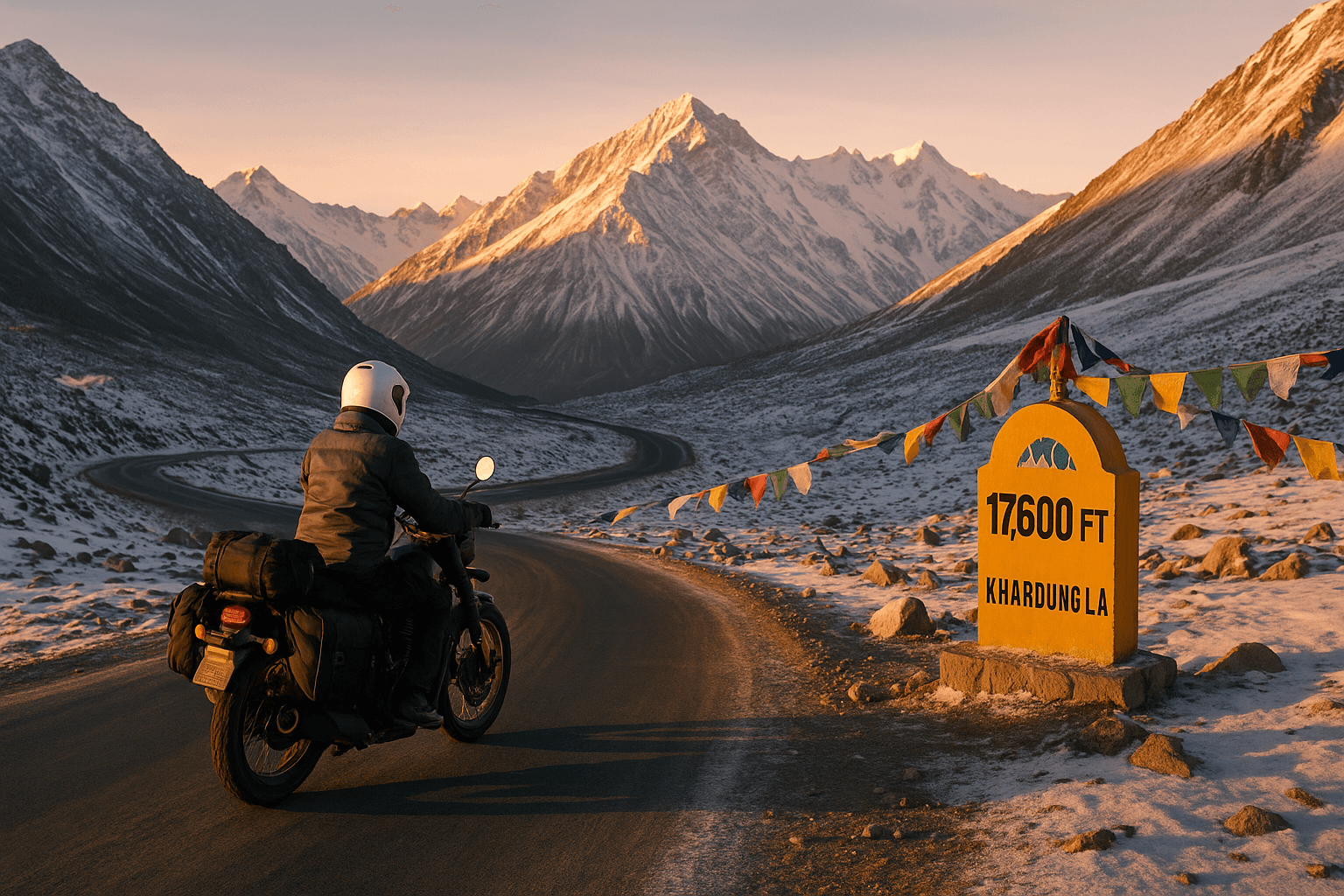
Delhi sits near 700 ft above sea level. By the time your bike reaches Khardung La four days later, you’re standing at 17,600 ft—half the oxygen, three times the UV radiation, and wind that stings like ground glass. Many riders spend months planning gear and routes but treat their own lungs as an after-thought. Every June, ambulances ferry visitors down from Sarchu and Pangong with splitting heads and churning stomachs—classic acute mountain sickness (AMS). This guide gathers field-tested Ladakh AMS tips from army medics, local guides, and riders who logged the full Delhi-Manali-Leh loop dozens of times.
1. Know the Altitude Ladder from Delhi Upwards
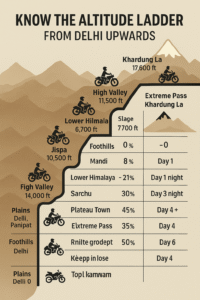
| Stage | Typical Stop | Elevation | Oxygen drop vs. Delhi | Days on the saddle |
|---|---|---|---|---|
| Plains | Delhi, Panipat | 700 ft | — | Day 0 |
| Foothills | Mandi | 2,600 ft | 8 % | Day 1 |
| Lower Himalaya | Manali | 6,700 ft | 21 % | Day 1 night |
| High Valley | Jispa | 10,500 ft | 30 % | Day 2 night |
| Alpine Desert | Sarchu | 14,000 ft | 40 % | Day 3 night |
| Plateau Town | Leh | 11,500 ft | 35 % | Day 4 + |
| Extreme Pass | Khardung La | 17,600 ft | 50 % | Day 6 |
The body usually handles a 10 % drop without fuss. Cross the 30 % line and oxygen debt builds quickly. Every plan below works around that fact.
2. Design a Slow-Step Climb
Delhi riders often try to reach Leh in three nights. That shortcut is a ticket to the army clinic. Stick to a four-night ascent:
-
Delhi → Mandi — hot plains, sugarcane stalls, end at 2,600 ft.
-
Mandi → Jispa — through Atal Tunnel, sleep at 10,500 ft, lungs get their first real lesson.
-
Jispa → Sarchu — stop early afternoon, walk gentle loops, no beer, no loud music, bed by 8 p.m.
-
Sarchu → Leh — climb Tanglang La, then descend to 11,500 ft for a safer night’s rest.
-
Leh rest day — permits, cafés, short monastery walk, lots of water.
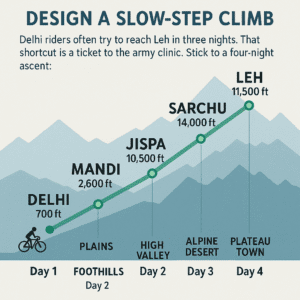
That one extra night between Manali and Leh removes half the emergency evacuations we see in rider logs.
✅ Government & Permit Info
3. Hydration—Your First Line of Defense
The lowest-cost Ladakh AMS tip is a ten-rupee ORS packet. Dehydration thickens blood, slows oxygen delivery, and triggers headaches. Habit stack it:
-
500 ml at Delhi dawn ride-out.
-
500 ml every fuel stop.
-
250 ml every meal stop.
-
Top up at camp until urine runs pale.
Hot lemon-honey at dhabas beats cola; caffeine and fizz pull water out of cells.
4. Eat Like a Mountain Shepherd
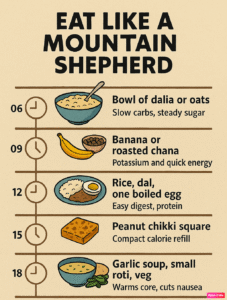
High altitude reduces appetite yet burns calories faster. Follow the “little-but-often” rule:
| Time | Food idea | Why it helps |
|---|---|---|
| 06:00 | Bowl of dalia or oats | Slow carbs, steady sugar |
| 09:00 | Banana or roasted chana | Potassium and quick energy |
| 12:00 | Rice, dal, one boiled egg | Easy digest, protein |
| 15:00 | Peanut chikki square | Compact calorie refill |
| 18:00 | Garlic soup, small roti, veg | Warms core, cuts nausea |
Skip deep-fried snacks after 4 p.m.; heavy fat lingers in a slowed gut and spikes reflux at night.
5. Dress Warm to Stay Oxygen-Rich
Cold constricts vessels and starves muscles. Layer math for Delhi-to-Ladakh:
-
Base — merino or synthetic thermal.
-
Mid — fleece hoodie.
-
Insulation — down jacket (packs to 1 L).
-
Shell — windproof textile riding coat.
-
Neck tube + warm gloves — most heat escapes neck and wrists.
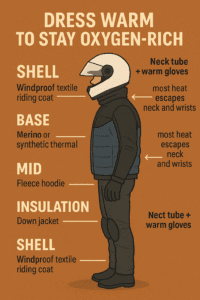
Add or shed layers at each rest stop; sweat trapped inside becomes ice at the next pass.
6. Breathing Routines on the Bike
Thin air invites shallow panting that raises heart rate. Use the “4-1-4” drill every ten switchbacks:
-
Inhale nose-only for a 4-count.
-
Hold for 1.
-
Exhale mouth-only for 4.
This empties stale air and resets rhythm. At night inside the sleeping bag, try “pursed-lip breathing”—inhale 2, exhale 4 through tight lips—to calm midnight thumping.
7. Monitor Your Vitals
Keep a finger pulse oximeter in the jacket chest pocket. Morning protocol:
-
Sit in bed two minutes.
-
Clip meter.
-
Log SpO₂ and pulse.
| SpO₂ reading | Meaning | Move |
|---|---|---|
| 92 %+ | Good | Ride on |
| 88–91 % | Mild deficit | Extra water, easy day |
| <88 % | High risk | Descend at least 1,000 ft |
Look at trends, not single numbers. A steady drop over two mornings signals trouble.
8. When to Use Diamox
-
Start 125 mg twice daily 24 h before Jispa if doctor approves.
-
Continue to Leh rest day.
-
Extra litre of water per day (it’s a diuretic).
Contra-indications: sulfa allergy, kidney disease, pregnancy. Test one tablet at home; tingling fingers are normal, rash is a stop sign.
9. Night Routine in High Camps
-
Light walk after dinner to aid digestion.
-
Layer socks—but keep them loose.
-
Prop head 10 cm higher than feet.
-
Keep flask of warm water within reach.
-
If breathless, sit up, sip, practise pursed-lip breathing.
Earplugs help; heartbeats sound louder in thin air and can keep light sleepers awake.
10. Oxygen Kit and First-Response Steps
Pack a 650-litre portable O₂ can. Steps if a rider collapses at Baralacha La:
-
Move to shade or windbreak.
-
Loosen jacket and belt.
-
Two slow puffs of oxygen.
-
Check SpO₂.
-
Load pillion onto guide bike, descend to Darcha (9,800 ft).
-
Recheck in 30 minutes. Hospital only if confusion or SpO₂ < 88 % persists.
Small cylinders cost ₹600 and fit a tank bag side pocket.
11. Load Your Bike for Lung-Friendly Riding
Heavy top boxes force you to grip bars tighter, spiking pulse. Keep ballast low:
-
Tools and fuel can in left saddlebag.
-
Sleeping gear and clothes in right.
-
Tail pack under 5 kg.
-
Nothing high on luggage rack except tripod or tent poles.
Balanced weight means smaller steering corrections and steadier breathing.
12. Communication Signals in Thin Air
Visor vents whistle; verbal shouts fade. Define three hand moves before leaving Delhi:
-
Fist on helmet – water stop now.
-
Index swirl above head – dizziness, slow pace.
-
Flat palm chopping down – urgent descent.
Practice them at the Delhi toll booth—or take a short warm-up ride beforehand. muscle memory matters at 16 000 ft.
13. AMS Case Log—Learn from Others
Case A
Rider pushed Manali to Sarchu in one shot. Slept at 14 000 ft the same night. Woke at 2 a.m. with splitting head, SpO₂ = 82 %. Evacuated to Keylong, recovered in six hours. Lesson: never sleep over 12 000 ft the first night above 10 000 ft.
Case B
Group of four skipped lunch on Nubra–Pangong shortcut. Afternoon wind chill + low glucose = shivering and slurred speech. Warm tea, peanut bars, fleece layer fixed all within an hour. Lesson: calories fight cold and AMS.
14. Mental Hacks to Ease AMS
-
Sing slow verses inside the helmet. Calms cadence.
-
Count milestones backward: keeps mind busy, reduces anxiety.
-
Set mini-goals (next hairpin) instead of staring at distant pass top.
A calm rider saves oxygen.
🏥 Medical & Altitude Sickness Resources
-
Wilderness Medical Society – 2024 Clinical Practice Guidelines
Comprehensive guidelines on prevention, diagnosis, and treatment of acute altitude illnesses.
🔗 Read the guidelines -
NHS UK: Altitude Sickness Overview
Detailed information on symptoms, prevention, and treatment of altitude sickness.
🔗 Visit NHS -
CDC Travelers’ Health: High Altitude Travel
Advice for travelers on acclimatization and health risks at high altitudes.
🔗 CDC Guide -
UIAA Medical Commission – High Altitude Advice
Recommendations for climbers and trekkers on managing health at high elevations.
🔗 UIAA Medical Advice
15. Recovery After Returning to Delhi
-
Two days of eight-hour sleep.
-
Double water intake first 48 h.
-
No intense gym for a week—heart needs normalization.
-
If cough or breathlessness lingers, see a doctor; high altitude bronchitis can trail you.
16. Quick-Check Pocket Card (print and laminate)
| Action | Interval |
|---|---|
| 250 ml water | 30 min riding |
| Breathing drill | 20 min climbing |
| Snack | 3 h |
| SpO₂ reading | Morning |
| Layer check | Every stop |
Tape it to tank bag lid so partners can remind one another.
Final Words
Every Ladakh AMS tip here funnels to one idea: respect the climb from Delhi’s low air to Ladakh’s sky-level deserts. Ride in steps, sip steadily, eat light but often, stay warm, breathe deep, watch your pulse, and bail out early if symptoms spike. Treat the route as a dialogue with your body, not a race to a summit signboard, and the mountains will likely greet you with clear lungs, clear eyes, and that grin riders carry all the way back to the plains.
